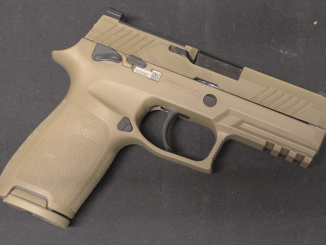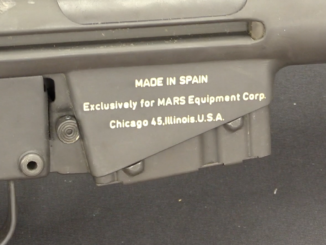This transferrable 1919 tank MG is being sold at Morphys on October 30, 2018.
In 1918 the United States began manufacturing tanks for the war effort in Europe, and these tanks naturally required armament. The British were mostly using the Hotchkiss Portative for they new tanks and the French were using the Hotchkiss 1914 heavy machine gun. The initial American weapon of choice for tanks was the Marlin 1917, as straight gas piston conversion of the Colt 1895 design – but the Marlin had substantial flaws and a better gun was desired.




“a better gun was desired.”re the Marlin always amuses me, when in 1940 virtually the entire stock of Marlin’s held in the USA were sent off to the UK, to help replace the losses from the French Campaign. The cost of the weapons was charged at the rate of replacement M1919A2’s, and when they arrived the majority did not have field mounts. The Army refused to have anything to do with them, and the vast majority went off the Merchant Navy to provide a form of anti-aircraft defence. To solve the problems with the weapon jamming, subsequently the Maritime Regiment Royal Artillery issued each gun with a 5lb Ball Pein Hammer ( US machinists hammer), these having their hammer head faces faced with lead or brass, to reduce damage to the weapons when belted hard by the gunner to clear them. They in particular proved their worth when nothing better available, in the vital coal collier convoys from the North East of England down the English Channel to the power stations of the London area, which the Luftwaffe totally failed to stop. So there nothing better, but, they did prove their worth, and were still seen on merchant ships in 1945.
“when in 1940 virtually the entire stock of Marlin’s held in the USA were sent off to the UK, to help replace the losses from the French Campaign.”
Interestingly similar situation happen with Marlin machine guns, but with Kingdom of Italy instead of United Kingdom and Regia Marina rather than Merchant Navy.
From query M1895 Colt-Browning machine gun in en wikipedia
A number of Colt and Marlin-made machine guns was also provided to Italian forces during World War I to replace similar weapons lost in the retreat that followed the massive Austrian-German breakthrough at the Battle of Caporetto. Besides being chambered for the standard 6.5×52mm Mannlicher–Carcano Italian rifle cartridge, they were converted to liquid cooling with the installation of a narrow brass sleeve around the barrel; M1895/14 machine guns receiving this modification were designated “6.5/80” and employed by the Regia Marina (Royal Italian Navy) as a field weapon for Marine infantrymen defending the mouth of the Piave river. They also appeared on Navy vessels, with as many as four equipping each Italian MAS (torpedo boat), on “Class F” submarines and on some destroyers. The MAS used by Gabriele D’Annunzio in the famous Beffa di Buccari and displayed at his former residence (Vittoriale degli italiani) still mounts a Colt M1895.
Note: 80 in designation probably refers to length of barrel in calibers (practice used by Regia Marina during Great War in regard to naval cannons) and would imply 520 mm long barrel.
Linked query in it wikipedia, titled Colt-Browning M1895 has chapter Le Colt-Browning italiane about Italian use of that machine guns:
https://it.wikipedia.org/wiki/Colt-Browning_M1895#Le_Colt-Browning_italiane
looks to give same information as English version, but with addition of
Durante la Seconda guerra mondiale alcuni esemplari erano ancora impiegati dalla DICAT e dalla Milmart per la difesa contraerea del territorio metropolitano.
If I understand it correctly enough, at least some examples were used during 2nd World War by DICAT, which looks to be Italian AA defense organization, which apparently for some reason was part of MVSN not Royal Italian Army.
To be clear the Italians received the 1917 improved “potato digger” which still looked like the 95/14’s with swing lever, not the later developed Marlin guns built for tank and aircraft useage.
Also these guns were pursuant to contracts with the Italian Navy (and also Russia). Marlin took over those contracts when they purchased the Colt 1914 tooling.
Milmart was the coastal artillery branch also part of the MVSN, although it operated under the command of the Regia Marina. Apparently giving coastal artillery to the Blackshirts was a good idea in the minds of the Fascists. However, the Navy continued to operate some of the more important batteries directly with Navy personnel and only perimeter, air and beach defense was given to the Milmart in those cases. It sounds more complicated than it actually was, since all the Milmart units were under Navy command in any case.
The DICAT air defense organization made a little bit more sense, because it created the first anti-aircraft organization responsible for defending metropolitan Italy from air attacks.
“Marlin 1917, as straight gas piston conversion of the Colt 1895”
According to http://www.airwar.ru/weapon/guns/coltm1895.html Marlin 1917 also introduced improving cooling, in form of aluminum part (heat sink if it is proper term) – this is that silver-colored part at first photo from top here:
http://peashooter85.tumblr.com/post/136982852789/the-marlin-model-19171918-machine-gun-in-1914
Notice that Marlin version was also firing faster than original Colt Potato Digger (~650 rpm vs 400…450 rpm), though I do not know if that was intentional.
Also note that rework was executed by Carl Gustave Swebilius, you might hear that name earlier, as a designer of UD42 sub-machine gun used during WWII by OSS and also known as Marlin, though during its history another producer appears United Defense Supply Corp., though I am not sure about relations between these two entities – did United Defense Supply Corp. outsourced actual production capability from Marlin Firearms?
BTW: Did anyone consider requesting J.M.Browning about possibility of “actualization” of Colt Potato Digger into more modern form, without that swinging arm?
Interesting article:
https://blogs.scientificamerican.com/anecdotes-from-the-archive/manufacturing-machine-guns-by-the-thousand-1917/
…political question was raised during the [Great] war and remained afterward: Did arms manufacturers help push the United States into joining the Great War as a combatant because of a desire to profit from war production?
(…)
committee worked from 1934 to 1936; their report did not present evidence that arms manufacturers had conspired to drag the country into the war…
“Marlin 1917, as straight gas piston conversion of the Colt 1895”
According to https://www.ibiblio.org/hyperwar/USN/ref/MG/I/MG-4.html#5 it was not so easy as it might looks, citing from link:
Swebilius deserves great credit for accomplishing this most difficult task, especially since it was performed in a few weeks’ time. In this short period he made the Marlin gun a reliable automatic arm that was used throughout the war and for 3 years afterwards as the principal synchronized automatic machine gun of the American air force. Later it was also adapted to tank use. The weapon met with considerable enthusiasm on the western front as the following cablegram from A.E.F. headquarters in February 1918 shows: “Marlin aircraft guns have been fired successfully on four trips from 13,000 to 15,000 feet altitudes at a temperature of -20 degrees Fahrenheit. On one trip guns completely covered with ice. Both metallic links and fabric belts proved satisfactory.”
This looks an awful lot like the 1919A2 cavalry mg.Shorter barrel,light weight etc.